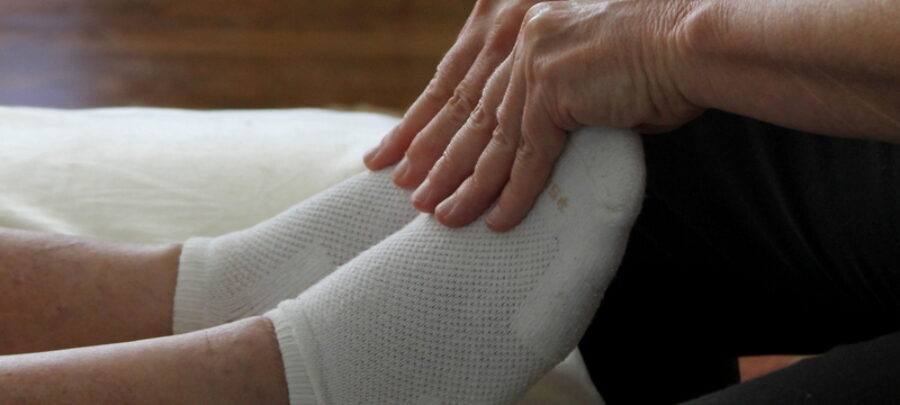We’ve spent weeks digesting guidelines and warnings from the AMTA, ABMP, the CDC, OSHA, CMS and numerous leaders in the massage industry, including our esteemed colleagues in oncology care.
We’ve consulted the NHPCO, NCHPC, HPNA and other organizations that govern hospice practice, while engaging in countless conversations (via telephone, Zoom and a few masked encounters) with our hospice colleagues.
These are the two worlds we straddle – the massage world and the hospice world. As some of you have likely discovered, it is a difficult tightrope to walk right now.
The sources we respect in the massage world are adamant that it is not safe for us to practice massage in a world riddled with COVID-19. And they are right. Our hospice team members, meanwhile, have remained at the bedside, providing the same compassionate end-of-life care that they have always provided. And they are wondering where we are.
Most of us have complied with recent proclamations by governors prohibiting the practice of massage therapy. Some of those prohibitions are now being lifted. Which leaves us with some difficult decisions to make.
Now that it is (or soon will be) legal for us to practice massage, do we think we should? If the answer is yes, how can we protect our dying clients, their loved ones and ourselves? If the answer is no, what does that mean for the jobs we’ve fought for and committed to? Like many of our massage therapy colleagues, we’ve spent decades earning a legitimate role alongside other healthcare providers. Now that we’ve achieved that privilege, how do we honor our commitments as the professionals we’ve worked so hard to become?
The short answer to these questions is that we are working to find middle ground. In our minds, there is a lot of space between the extremes of abandoning our jobs and business-as-usual. We cannot presume to define those spaces for anyone else. We can only define them for ourselves. And we can share our thought processes and conclusions, which may or may not resemble yours.
In attempting to bridge the gap between safety and service, we began on April 23rd to offer adapted massage at the hospice inpatient unit, using a safety protocol that appears on our website at www.finaltouchtraining.com. We are sharing our protocol, not to represent it as a golden standard, or to suggest that it is risk-free. Our intention is only to be transparent and to open a conversation with others who are wrestling with the same questions we are. We hope you will share your experiences, so that we might all learn from one another.
You may come to different conclusions about your work than we have come to about ours. We respect any position that has involved a conscientious process involving the following steps.
- A period of discernment. You have likely already begun this process, consulting the same sources we have, thinking about your practice and how it might need to wait or change. The discernment process will be impacted by where you are and how COVID is impacting your region. There must be honesty in the process regarding our fears and our motivations. There must be room for the client’s needs, our needs, and the needs of the greater community. We have found it helpful to reach out to colleagues and mentors. But we’ve also endeavored to listen to our own wisdom, born of training and experience over a long period of time. We encourage you to do the same.
- A period of preparation. There can be no doubt that we will need to make changes in the way we do massage therapy. Massage will be different now, maybe forever, whether it is spa massage or medical massage. There will be new materials to gather and a need to gather those materials in a way that does not threaten a precarious supply chain. Some expense and creativity will likely be involved. We found a written protocol to be helpful, both for the purposes of getting necessary approvals and to retrain ourselves so that new steps become fluid habits. Only you will know when you’re truly ready.
- A commitment to long-term change. This may be the hardest step. Change can be inconvenient, time consuming and tedious. There will be more laundry to do, and (we have found) a new level of fatigue as we adapt to new practices. As the realities of the pandemic shift and outcomes emerge from our protocols, we will make changes to our changes. It will be a process. But “business as usual” will likely be out of reach for some time. COVID-19 will be a marathon, not a sprint. And marathons require stamina. We all need to take good care of ourselves.
We close with this final thought. As massage therapists specializing in oncology, palliative or hospice care, we are already accustomed to adapting our work for the safety of our clients. For us, the practice of massage has never been casual or routine. We are, by temperament and training, cautious and (hopefully) humble, built to “inch forward,” in Gayle MacDonald’s words. In your discernment, in your preparation, in your commitment, we wish you well. May your hands be blessed, may your spirits be sturdy, and may your bodies stay strong.
With affection and esteem,
Cindy and Susan

